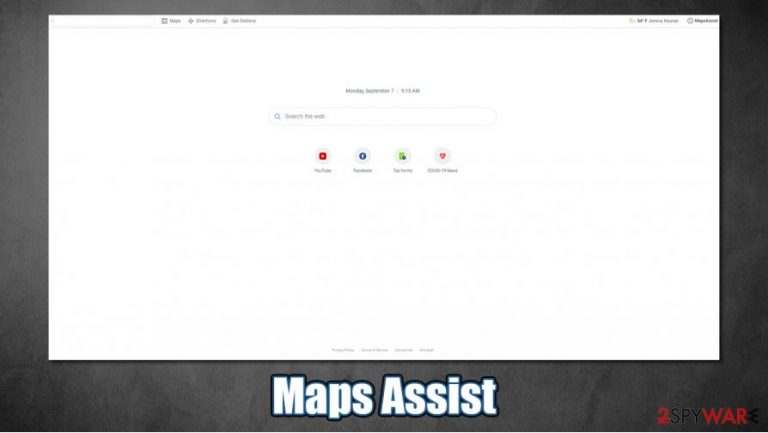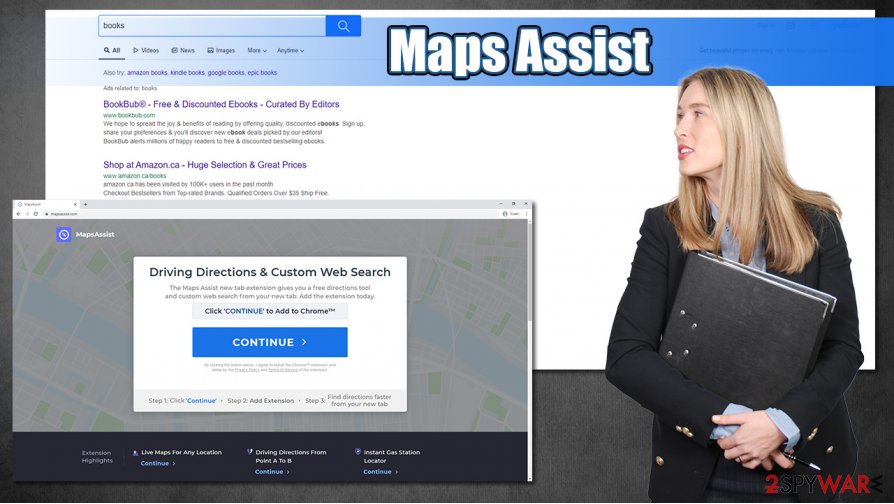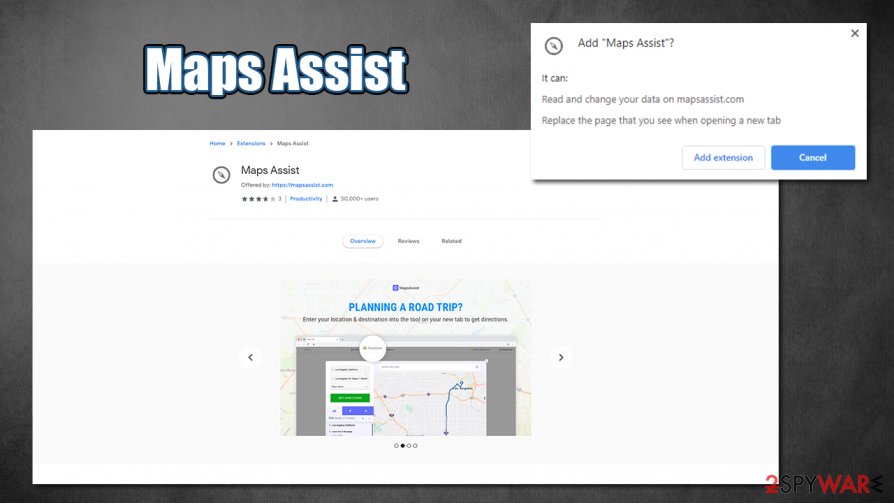Maps Assist (Removal Instructions) - Chrome, Firefox, IE, Edge
Maps Assist Removal Guide
What is Maps Assist?
Maps Assist is a browser hijacker that redirects all search results to Yahoo

Maps Assist is a potentially unwanted application that users can encounter when downloading freeware from third-party websites, among others. While the installation can sometimes be intentional via Chrome Store, most find it on their Google Chrome, Mozilla Firefox, Safari, or another browser, seemingly out of nowhere due to deceptive distribution techniques.
Once installed, Maps Assist will append an extension to the used browser and change other preferences, such as the new tab/homepage, which would be set to mapsassist.com. Additionally, a fake search engine is also presented to users – each time they search for something online, they will be redirected to Yahoo.
Unlike the original Yahoo engine, however, Maps Assist hijack would show alternative search results, most of which are filled with sponsored links that the top. In the background, the PUA collects a variety of information about users – the practice is very common and used for targeted advertising, as well as sharing of such details with affiliates, service providers, as well as third parties.
| Name | Maps Assist |
| Type | Browser hijacker, potentially unwanted program |
| Developer | Innover Group |
| Distribution | The extension can be downloaded from official sources, although most users install it through software bundle packages downloaded from third-party sites |
| Symptoms |
|
| Risks | Installation of other unwanted software/malware, information disclosure to unknown parties, monetary loss |
| Removal | To uninstall the app, access the extension section of your web browser; in case the hijack is related to an installed application, follow the steps we provide in our instructions below |
| Additional steps | In case you can not eliminate the extension or an application, you should reset the installed browsers, and perform scans with powerful anti-malware, as well as repair software such as FortectIntego |
Browser hijackers are extremely common and can be downloaded from many different places. While not considered as major security threats, these unwanted programs should not be ignored, especially if they showed up on the system without permission.
Some browser hijackers, such as Mazy Search, Flare Search, or Search Marquis, are known to set “Managed by your organization” on the web browser, which may prevent an easy termination of these apps. Thus, if you fail to remove Maps Assist in a regular way through the extensions section, there might be that there is another PUP installed on your system, or your browser settings are not allowing you to do that.
Maps Assist is an extension that attempts to flaunt its functionality, in this case – directions and maps assistance. The maps function identically to Google Maps, however, so there is nothing unique about this functionality. Even if you choose to use this feature, keep in mind that it comes with a (hidden) cost that might not be so apparent straight away.
As soon as the hijacker gains access to the web browser, it changes the homepage, the new tab, and the search engine to a customized one. This way, users who search via these tools will be rerouted to a well-known provider Yahoo. Unlike regular Yahoo results, however, users will be presented with several Maps Assist ads at the top – these links are used for monetization by the hijacker authors.
While showing ads is a common practice, you should keep in mind that the top results are paid for and are not organic.[1] As a result, the web browsing experience can be completely altered, and relevant information hard to find. In some cases, users might not even notice the “Ads” notification, and they might believe that their searches are genuine.

If you still wonder whether you should perform Maps Assist removal, you should check the website's Privacy Policy section. It soon becomes evident that the developers gather a large portion of information about you, some of which might be shared with third parties for marketing purposes. Examples of such collected data include:
- IP address and Internet Service Provider (ISP)
- Geolocation
- Browser and installed extension information
- Links clicked
- Sites visited
- Wallpapers downloaded
- Uploaded files
- Flight routes, etc.
As evident, such extensive data harvesting might cause serious privacy issues in case these details end up in cybercriminals' hands. Therefore, experts[2] advise not risking and preventing third-parties from tracking you. As evident, the solution is to uninstall Maps Assist ASAP.
To do that, you should get rid of the Maps Assist extension – simply access browser settings. In some cases, the hijack could be related to another program installed on your system. In such a case, we recommend scanning the device with anti-malware such as SpyHunter 5Combo Cleaner or Malwarebytes and then fixing possible virus damage with FortectIntego repair utility.
You can easily prevent unintentional installation of unwanted programs
Trojans[3] are known to be installed when users believe that they are installing a legitimate program on their computer. The best example is a pirated application installer that offers to bypass the program's licensing process, allowing it to be used for free. Similarly, browser hijackers end up on users' computers without permission, although the major difference is that they install PUPs themselves – although they are tricked into doing so in the first place.
Software bundling is one of the most common PUP distribution tactics used regularly by various freeware authors and software distribution sites. This tactic involves incorporating several applications into a single installer and then tricking users into installing them unintentionally. For that, several deceptive methods are used, including:
- Hiding optional programs under the Advanced/Custom installation settings;
- Providing misleading button placements during the installation;
- Including relevant information within the fine print, most of which is never read by users;
- Pre-ticking checkboxes so that users miss the agreement of the installation of optional apps.
Thus, you should be vigilant when you install software from third-party sources (we recommend staying away from pirated programs and software cracks altogether – your machine could easily be infected with malware) – always pick Advanced/Custom settings instead of Recommended ones, read the installation instructions/fine print, untick checkboxes, and install powerful anti-malware that would warn you about potentially unwanted programs.

Maps Assist removal instructions
As previously mentioned, there should not be too much trouble when trying to remove Maps Assist. This application typically comes as an extension and can be found either as an icon in the corner of the window or by accessing the settings of the web browser. However, there might be some difficulties when trying to uninstall the unwanted programs, as they might hijack the browser significantly (e.g., the “Managed by your organization” feature might prevent the elimination of the extension).
In such a case, Maps Assist removal can be performed with the help of browser reset – you can find the details below. Additionally, unwanted applications might also be installed on your system; you should check the installed program section via Control Panel (Windows) or Applications folder (Mac). Furthermore, you should also perform a full system scan with powerful anti-malware – it should also allow you to get rid of the invisible threats that could be present on your machine.
You may remove virus damage with a help of FortectIntego. SpyHunter 5Combo Cleaner and Malwarebytes are recommended to detect potentially unwanted programs and viruses with all their files and registry entries that are related to them.
Getting rid of Maps Assist. Follow these steps
Uninstall from Windows
Instructions for Windows 10/8 machines:
- Enter Control Panel into Windows search box and hit Enter or click on the search result.
- Under Programs, select Uninstall a program.

- From the list, find the entry of the suspicious program.
- Right-click on the application and select Uninstall.
- If User Account Control shows up, click Yes.
- Wait till uninstallation process is complete and click OK.

If you are Windows 7/XP user, proceed with the following instructions:
- Click on Windows Start > Control Panel located on the right pane (if you are Windows XP user, click on Add/Remove Programs).
- In Control Panel, select Programs > Uninstall a program.

- Pick the unwanted application by clicking on it once.
- At the top, click Uninstall/Change.
- In the confirmation prompt, pick Yes.
- Click OK once the removal process is finished.
Delete from macOS
To delete unwanted apps from a Mac, follow these steps:
Remove items from Applications folder:
- From the menu bar, select Go > Applications.
- In the Applications folder, look for all related entries.
- Click on the app and drag it to Trash (or right-click and pick Move to Trash)

To fully remove an unwanted app, you need to access Application Support, LaunchAgents, and LaunchDaemons folders and delete relevant files:
- Select Go > Go to Folder.
- Enter /Library/Application Support and click Go or press Enter.
- In the Application Support folder, look for any dubious entries and then delete them.
- Now enter /Library/LaunchAgents and /Library/LaunchDaemons folders the same way and terminate all the related .plist files.

Remove from Microsoft Edge
Delete unwanted extensions from MS Edge:
- Select Menu (three horizontal dots at the top-right of the browser window) and pick Extensions.
- From the list, pick the extension and click on the Gear icon.
- Click on Uninstall at the bottom.

Clear cookies and other browser data:
- Click on the Menu (three horizontal dots at the top-right of the browser window) and select Privacy & security.
- Under Clear browsing data, pick Choose what to clear.
- Select everything (apart from passwords, although you might want to include Media licenses as well, if applicable) and click on Clear.

Restore new tab and homepage settings:
- Click the menu icon and choose Settings.
- Then find On startup section.
- Click Disable if you found any suspicious domain.
Reset MS Edge if the above steps did not work:
- Press on Ctrl + Shift + Esc to open Task Manager.
- Click on More details arrow at the bottom of the window.
- Select Details tab.
- Now scroll down and locate every entry with Microsoft Edge name in it. Right-click on each of them and select End Task to stop MS Edge from running.

If this solution failed to help you, you need to use an advanced Edge reset method. Note that you need to backup your data before proceeding.
- Find the following folder on your computer: C:\\Users\\%username%\\AppData\\Local\\Packages\\Microsoft.MicrosoftEdge_8wekyb3d8bbwe.
- Press Ctrl + A on your keyboard to select all folders.
- Right-click on them and pick Delete

- Now right-click on the Start button and pick Windows PowerShell (Admin).
- When the new window opens, copy and paste the following command, and then press Enter:
Get-AppXPackage -AllUsers -Name Microsoft.MicrosoftEdge | Foreach {Add-AppxPackage -DisableDevelopmentMode -Register “$($_.InstallLocation)\\AppXManifest.xml” -Verbose

Instructions for Chromium-based Edge
Delete extensions from MS Edge (Chromium):
- Open Edge and click select Settings > Extensions.
- Delete unwanted extensions by clicking Remove.

Clear cache and site data:
- Click on Menu and go to Settings.
- Select Privacy, search and services.
- Under Clear browsing data, pick Choose what to clear.
- Under Time range, pick All time.
- Select Clear now.

Reset Chromium-based MS Edge:
- Click on Menu and select Settings.
- On the left side, pick Reset settings.
- Select Restore settings to their default values.
- Confirm with Reset.

Remove from Mozilla Firefox (FF)
Firefox should be reset if you are unable to get rid of some extensions:
Remove dangerous extensions:
- Open Mozilla Firefox browser and click on the Menu (three horizontal lines at the top-right of the window).
- Select Add-ons.
- In here, select unwanted plugin and click Remove.

Reset the homepage:
- Click three horizontal lines at the top right corner to open the menu.
- Choose Options.
- Under Home options, enter your preferred site that will open every time you newly open the Mozilla Firefox.
Clear cookies and site data:
- Click Menu and pick Settings.
- Go to Privacy & Security section.
- Scroll down to locate Cookies and Site Data.
- Click on Clear Data…
- Select Cookies and Site Data, as well as Cached Web Content and press Clear.

Reset Mozilla Firefox
If clearing the browser as explained above did not help, reset Mozilla Firefox:
- Open Mozilla Firefox browser and click the Menu.
- Go to Help and then choose Troubleshooting Information.

- Under Give Firefox a tune up section, click on Refresh Firefox…
- Once the pop-up shows up, confirm the action by pressing on Refresh Firefox.

Remove from Google Chrome
Some hijackers may leave unwanted components even after their uninstallation. In such a case, reset Google Chrome as explained below
Delete malicious extensions from Google Chrome:
- Open Google Chrome, click on the Menu (three vertical dots at the top-right corner) and select More tools > Extensions.
- In the newly opened window, you will see all the installed extensions. Uninstall all the suspicious plugins that might be related to the unwanted program by clicking Remove.

Clear cache and web data from Chrome:
- Click on Menu and pick Settings.
- Under Privacy and security, select Clear browsing data.
- Select Browsing history, Cookies and other site data, as well as Cached images and files.
- Click Clear data.

Change your homepage:
- Click menu and choose Settings.
- Look for a suspicious site in the On startup section.
- Click on Open a specific or set of pages and click on three dots to find the Remove option.
Reset Google Chrome:
If the previous methods did not help you, reset Google Chrome to eliminate all the unwanted components:
- Click on Menu and select Settings.
- In the Settings, scroll down and click Advanced.
- Scroll down and locate Reset and clean up section.
- Now click Restore settings to their original defaults.
- Confirm with Reset settings.

Delete from Safari
Remove unwanted extensions from Safari:
- Click Safari > Preferences…
- In the new window, pick Extensions.
- Select the unwanted extension and select Uninstall.

Clear cookies and other website data from Safari:
- Click Safari > Clear History…
- From the drop-down menu under Clear, pick all history.
- Confirm with Clear History.

Reset Safari if the above-mentioned steps did not help you:
- Click Safari > Preferences…
- Go to Advanced tab.
- Tick the Show Develop menu in menu bar.
- From the menu bar, click Develop, and then select Empty Caches.

After uninstalling this potentially unwanted program (PUP) and fixing each of your web browsers, we recommend you to scan your PC system with a reputable anti-spyware. This will help you to get rid of Maps Assist registry traces and will also identify related parasites or possible malware infections on your computer. For that you can use our top-rated malware remover: FortectIntego, SpyHunter 5Combo Cleaner or Malwarebytes.
How to prevent from getting browser hijacker
Stream videos without limitations, no matter where you are
There are multiple parties that could find out almost anything about you by checking your online activity. While this is highly unlikely, advertisers and tech companies are constantly tracking you online. The first step to privacy should be a secure browser that focuses on tracker reduction to a minimum.
Even if you employ a secure browser, you will not be able to access websites that are restricted due to local government laws or other reasons. In other words, you may not be able to stream Disney+ or US-based Netflix in some countries. To bypass these restrictions, you can employ a powerful Private Internet Access VPN, which provides dedicated servers for torrenting and streaming, not slowing you down in the process.
Data backups are important – recover your lost files
Ransomware is one of the biggest threats to personal data. Once it is executed on a machine, it launches a sophisticated encryption algorithm that locks all your files, although it does not destroy them. The most common misconception is that anti-malware software can return files to their previous states. This is not true, however, and data remains locked after the malicious payload is deleted.
While regular data backups are the only secure method to recover your files after a ransomware attack, tools such as Data Recovery Pro can also be effective and restore at least some of your lost data.
- ^ Organic search. Wikipedia. The free encyclopedia.
- ^ Novirus. Novirus. Cybersecurity news and malware insights.
- ^ What are Trojans on Computers?. Comodo. Creating Trust Online.
